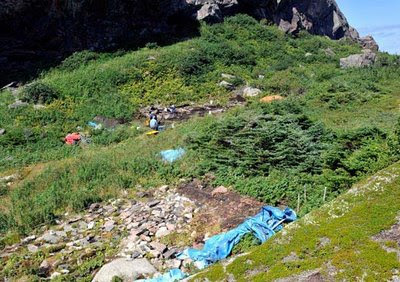The Basques Were Here
In arctic Canada, a Smithsonian researcher discovers evidence of Basque trading with North America
Photo Gallery
Bill Fitzhugh knew he'd found something when he stepped off his research boat in the summer of 2001 at Quebec's Hare Harbor and saw red tiles beneath wet moss.
Fitzhugh, director of the Smithsonian's Arctic Studies Center at the National Museum of Natural History, had sailed up Canada's coast in search of Basque sites. The curved red tiles caught his eye because they were unique to Basque buildings. For the next seven summers Fitzhugh returned to the same spot to lead an archaeological dig.
Though the Basques were a major presence in Canada and South America from the 16th to the 18th centuries, physical evidence of their activities has been scant—and that's what Fitzhugh has been after. An independent people, the Basques originated in the mountainous region of southwest France and northwest Spain. They were master mariners and some of the first to ply the waters between Europe and the New World. Basque traders set up summertime camps on Canada's east coast. They fished cod and hunted whales, harvesting the meat and oil to sell in Europe. Historians have frequently overlooked the Basques because unlike later British, French and Dutch explorers, the Basque interest in the New World was purely commercial.
"The Basques didn't go around planting flags. They just made money and weren't really interested in anything else," says Mark Kurlansky, author of The Basque History of the World.
Previous archaeologists had found evidence of Basque outposts at Red Bay on the Strait of Belle Isle in New Foundland, where the Basque harvested whales well into the late 16th century. When Fitzhugh began excavations at Hare Harbor, 150 miles west of Red Bay, he assumed he'd find remnants from the same period.
But Fitzhugh's work has unearthed two surprises. In early excavations at the site, he found colorful glass trade beads mixed in with distinctive Basque iron implements. Trade beads were used as currency by the Basque and other Europeans in their dealings with indigenous tribes. Lab studies revealed that these beads had been manufactured between 1680 and 1720—the first archaeological evidence that the Basques had continued to travel to Canada into the early 18th century.
The second surprise surfaced this past summer. The team began excavating what they thought was a midden, a pile of trash left behind when a settlement or camp is abandoned. Instead, they found a Basque blacksmith shop. The floors and walls were charred, suggesting there had been a fire. Then, when Fitzhugh lifted up the floor's stone paving slabs, he found another charred wooden floor. Scattered about were toys carved from soapstone, a form of Inuit handiwork. "That's when we knew we had an Inuit family at the site," Fitzhugh says.
Cont. here:http://www.smithsonianmag.com/arts-culture/Joint-Effort.html#
© History Chasers
Click here to view all recent Searching for the Lost Colony DNA Blog posts









